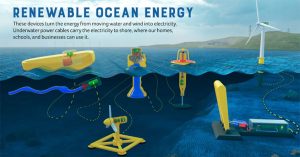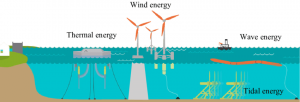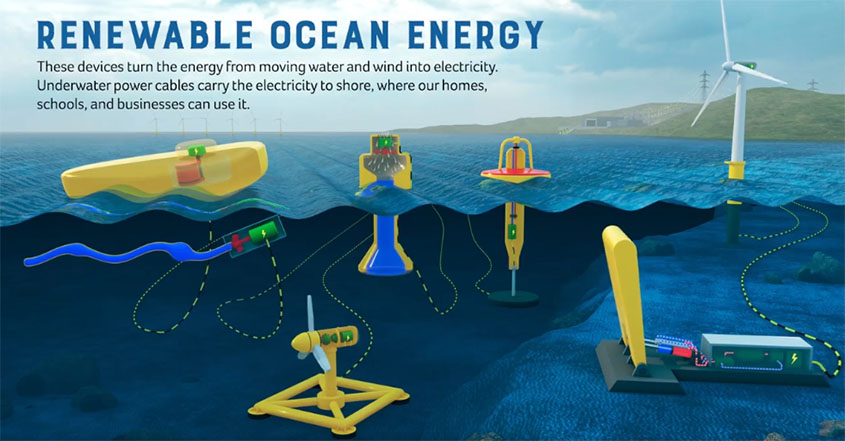
Marine renewable energy refers to the generation of electricity from renewable sources located in or near bodies of water, including oceans, rivers, and lakes. Marine renewable energy sources include offshore wind, tidal energy, wave energy, and ocean thermal energy conversion. Marine renewable energy is a rapidly growing industry that involves harnessing the power of the ocean to generate electricity. The potential for marine renewable energy is significant, as the ocean provides a vast and largely untapped source of clean, renewable energy. The main types of marine renewable energy include offshore wind, tidal energy, wave energy, and ocean thermal energy conversion (OTEC).
Some of the key aspects of marine renewable energy include:
Offshore Wind: Offshore wind turbines are installed in bodies of water, typically in areas with high wind speeds and low water depths. These turbines generate electricity from wind energy, which is then transmitted to the onshore grid.Offshore wind is a type of marine renewable energy that involves installing wind turbines in bodies of water, typically in areas with high wind speeds and low water depths. Offshore wind turbines are much larger than their onshore counterparts and are designed to withstand harsh ocean conditions. The turbines generate electricity from wind energy, which is then transmitted to the onshore grid via underwater cables. Offshore wind is becoming an increasingly popular form of renewable energy, as it has the potential to generate large amounts of electricity and can be installed relatively quickly.
Tidal Energy: Tidal energy is generated by harnessing the power of ocean tides, which are caused by the gravitational pull of the moon and sun. Tidal energy can be generated using tidal barrages, which are structures that capture and release water to generate electricity, or using tidal turbines, which operate like underwater wind turbines.Tidal energy is another type of marine renewable energy that involves harnessing the power of ocean tides. Tidal energy is generated using tidal barrages, which are structures that capture and release water to generate electricity, or using tidal turbines, which operate like underwater wind turbines. Tidal energy is a predictable and reliable source of renewable energy, as tides are largely influenced by the gravitational pull of the moon and sun.
Wave Energy: Wave energy is generated by harnessing the power of ocean waves, which are caused by wind and currents. Wave energy can be generated using a variety of technologies, including oscillating water columns, point absorbers, and attenuators. Wave energy is generated by harnessing the power of ocean waves, which are caused by wind and currents. Wave energy can be generated using a variety of technologies, including oscillating water columns, point absorbers, and attenuators. Wave energy is a promising form of renewable energy, as it has the potential to generate large amounts of electricity and is largely predictable.
Ocean Thermal Energy Conversion: Ocean thermal energy conversion (OTEC) is a process that generates electricity by harnessing the temperature difference between warm surface water and cold deep water. OTEC systems typically use a heat exchanger and a turbine to generate electricity. Ocean thermal energy conversion (OTEC) is a process that generates electricity by harnessing the temperature difference between warm surface water and cold deep water. OTEC systems typically use a heat exchanger and a turbine to generate electricity. OTEC is a promising form of renewable energy, as it has the potential to generate large amounts of electricity and is largely predictable. However, OTEC systems are currently quite expensive and are not widely used.

Overall, marine renewable energy is a promising source of renewable energy that has the potential to play an increasingly important role in the global energy mix. Marine renewable energy sources have the advantage of being predictable, reliable, and environmentally friendly, and can be located close to population centers, reducing transmission costs. However, the development of marine renewable energy faces a number of challenges, including high upfront costs, technical and regulatory barriers, and environmental impacts. Ongoing research and development, as well as continued investment in the industry, are critical to realizing the full potential of marine renewable energy.
In conclusion, marine renewable energy has significant potential to provide clean, renewable energy to communities around the world. While there are still technical and economic challenges associated with marine renewable energy, advances in technology and policy are helping to drive the growth of this important industry. As the world continues to shift towards a more sustainable future, marine renewable energy is likely to play an increasingly important role in meeting our energy needs.

